Sharlyn J. Lauby's Blog, page 74
December 10, 2020
7 Ways to Reward and Recognize Employees During the Holiday Season

We’re all reading the same headlines. The pandemic continues to take its toll on the workplace, regardless of whether you’re working in an office or remotely.
I came across an article in Fast Company that cited a study saying 68% of employees are more stressed out now than they were pre-pandemic. Add to that the stress that comes with a holiday and well, we’re talking about a lot of stress. Organizations can help employees during these stressful times by doing a few things differently.
Be flexible with time. In my experience, employers are typically flexible with employees during this time of year because of family obligations. Just because the Centers for Disease Control (CDC) are encouraging us all to stay home, doesn’t mean that employees won’t need some flexibility. It’s possible that they’re trying to do some Zoom family events in place of being in person. And it might take some coordination.
Rework the bonus program. At least temporarily. The last quarter of the year is often a time when organizations push employees a little harder. Much of that is tied to annual bonuses and goal achievement. I realize the pandemic has hurt businesses and revenue lines. If the company if offering some sort of incentive or bonus right now during the holiday, make sure it’s challenging and achievable. Not unrealistic and unnecessarily stressful.
Cancel the parties. Reallocate the budget. Yep, I’m saying it. Organizations like to celebrate a bit more during this time with client parties and employee parties. As much as we would all like a party, it’s risky from a health perspective. But don’t do nothing. Take some of that money and put it toward a gift that can be sent to a client or employee’s home.
Two small gifts could be better than one large gift. Years ago, I worked for a hotel that was super busy in December and slow in January. Instead of having a big holiday party in December, we had a small one. And a big party in January. It also helped that we had a new budget year in January. Organizations could use this philosophy when it comes to employee and client gifts. January is not too late to wish people a Happy New Year.
Don’t have the money for a gift? Consider time off. Some organizations might balk at the expense of buying and shipping gifts. That’s okay, every organization’s bank account looks different. But if you can’t purchase gifts, then consider a gift that doesn’t have a direct cost – like a day off. Maybe package a Day Off IOU in a holiday card that employees can redeem.
Remind employees about their benefits. Many organizations conduct their annual open enrollments during this time of year. It could be a perfect time to remind employees about their overall benefits package including employee assistance programs and mental health benefits. Also, if the company has negotiated any discount program perks – like savings on WW at Work – maybe employees can participate at home.
Thank employees for their hard work. And clients for their partnership. Finally, while gifts are great, this holiday season is an opportunity to connect with individuals. Let people know that you appreciate them. I know we’re all feeling some video call fatigue, but a nice note from the CEO or a personal call from the boss will really mean a lot to employees. And don’t forget to thank customers for their patience and patronage.
There’s lots of good news about vaccines and that’s wonderful but we’re not done with the pandemic yet. It possible that we will be dealing with the impact of this for several months. Use this time to thank employees for their support.
Image captured by Sharlyn Lauby while attending the Workhuman Conference in Nashville, TN
The post 7 Ways to Reward and Recognize Employees During the Holiday Season appeared first on hr bartender.






December 8, 2020
Improve the Candidate Experience with Better Scheduling
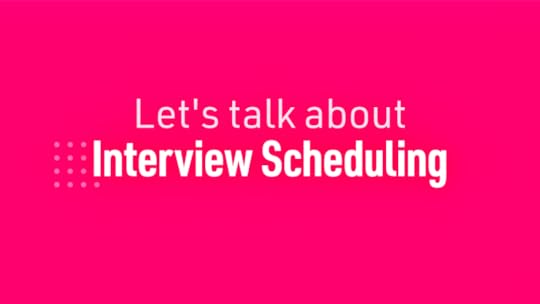
(Editor’s Note: Today’s article is brought to you by Cronofy , a global innovator in business scheduling software. It provides businesses with the technology they need to offer best-in-class scheduling. Enjoy the read!)
One of the great things about working in an office is being able to walk around the corner and say to a hiring manager, “Hey! I know this is last minute but are you available this afternoon to speak with a candidate?” Or at the end of a meeting, I might ask a couple of managers if they can tell me their availability for a panel interview. We can all look at our laptops/tablets/phones and quickly pick a date and time.
Now that more of us are working remotely, it’s a challenge to schedule interviews. Especially when multiple people are involved. However, hiring teams need a way to replicate that “in the office” experience and eliminate what you might call “phone tennis”. I know, the term phone tennis might sound funny. The reality is phone tennis is expensive.
Missing connections translates to time being wasted by the recruiter, the hiring manager, and the candidate. According to a survey conducted by Cronofy and JobAdder, 90% of recruiters say that they make two or more attempts (via email and/or phone) to schedule an interview. That time has a cost. And it’s not time that necessarily improves the candidate experience.
Reduce Administration Time with Automated Scheduling
The Cronofy Scheduler allows organizations to reduce their administrative time and focus on delivering a better candidate experience. Some of you might be familiar with Cronofy’s scheduling API (application programming interface). The Cronofy Scheduler is a stand-alone personalized scheduling app. I recently had a chance to test drive the Scheduler and wanted to share three things you might find interesting about the tool.
Privacy and Security. I once worked for a company where everyone could see everyone else’s calendar. During my time there, one of the things I learned was that our calendars are very personal. While none of us had any big secrets on our calendars, the act of granting someone access to your calendar is a very personal thing. With the Scheduler, you have the ability to share your availability for specified periods of time. No one can “see” your entire calendar. They can only see when you’re available.
Personalization. Once someone has access to your availability, it can be very frustrating when other people put appointments on your calendar, but they don’t pay attention to what’s before or after the appointment. This disregard of your time means that you’re usually placed in a position to either leave a meeting early or arrive at another meeting late (in order to attend the meeting that they’ve scheduled for you).
The Scheduler allows you to build in buffers to your meetings. You can use these buffers to take a last look at a candidate’s resume, run for a quick break, or simply just breathe. I’m not suggesting this to be funny. We know it’s true. That dash between meetings, even when you’re working remotely, doesn’t allow us to be our best for the interview. And that impacts the candidate experience.
Flexibility. The points I’ve mentioned so far aren’t exclusive to “big companies” or “small companies”. Privacy and security matter in every size organization. Personalization impacts everyone. The Cronofy Scheduler works with any size organization – from the HR department of one to an enterprise solution. It’s compatible with Microsoft Outlook and Gmail. With a Cronofy subscription, the Scheduler comes with 8×8 video conferencing as standard, but it integrates with all major conferencing services (i.e. Zoom, Microsoft Teams, Google Meet, and GoToMeeting).

In addition, candidates don’t have to fill in their personal details when they schedule an interview. The Scheduler automatically does that for them. So, there’s a perfectly seamless integration between the interviewer or hiring panel, the candidate, the Cronofy Scheduler, the calendar invite, and the location for the meeting.
Use Interviewing Resources to Build Relationships
I’ve always said that the goal of an interview was to create a conversation. That doesn’t mean we should stop asking questions, but rather figure out how to ask questions as part of a casual conversation. When organizations can turn interviews into conversations, then candidates feel comfortable sharing stories about their knowledge and skills. Organizations feel comfortable talking about the reasons employees like working there.
That’s what I really liked about the Cronofy Scheduler. It has the ability to create a process that allows us to stop wasting time and start building relationships, which frankly, is what recruiting is all about.
P.S. If you want to learn more about how the Cronofy Scheduler can help your organization reduce administrative time and improve the candidate experience, check out this case study “Introducing Wade & Wendy”. You can also test drive the Scheduler and sign up for a free account. It’s a good way to immediately see how scheduling software would positively impact your candidate experience.
The post Improve the Candidate Experience with Better Scheduling appeared first on hr bartender.






December 6, 2020
Be Part of the Solution – Part 3, Self Management Series
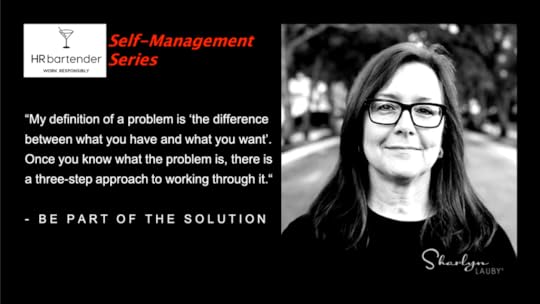
One of the things I miss about working in an office environment is the camaraderie. Especially when I’m faced with a problem. I can leave my office or cubicle and find someone to talk to or help me figure out a solution.
While we can do that to some extent working from home or the local coffee shop, it’s not the same. It’s not as easy to just pick up the phone and chat with a co-worker. In a self-managing work environment, we have to work through our problems on our own.
The first step in solving a problem is understanding whether the situation we’re faced with is really a problem. In the book “Polarity Management: Identifying and Managing Unsolvable Problems,” author Dr. Barry Johnson talks about the differences between problems and polarities. His theory is that sometimes we try to use a problem-solving approach seeking a solution on something that’s really not a problem at all.
My definition of a problem is “the difference between what you have and what you want.” Examples of problems include: “How do I get to the Florida Turnpike?” or “Should we merge with XYZ Company?” In these instances, once you get to the Turnpike or merge (or not) with XYZ Company, the problem is solved.
By contrast, a polarity occurs when you have two opposing forces. For example, centralization versus decentralization is a polarity. This is a polarity because neither centralization or decentralization are wrong – they are just two different approaches. And even when you choose one, you still have ongoing dynamics to deal with (translation: it’s not over.) Dr. Johnson elaborates in his book how polarities are not problems and the specifics of how to manage the opposing forces of a polarity. It’s a fascinating read.
But for now, let’s focus on problems and solutions. If you’ve analyzed the situation and know you have a problem, here’s a three-step approach to working through it. It’s known as the STP model of problem-solving. STP is an acronym for Situation – Target – Proposal. As you’re reading through the rest of this article, think about a problem that you’re currently experiencing. You can ask yourself the following questions:
Step One: Assess the SITUATION
During the Situationphase, you have the opportunity to examine the circumstances. Ask yourself the “who, what, where, when, why” questions to fully understand the matter. Also, don’t forget to ask questions about the extent of the problem, any patterns that might exist, and what the cause is. You’re able to collect any relevant information, understand the dynamics of the problem, and the possibilities in terms of changing the situation. Using one of the examples above, you’re driving along and realize you need to be on the Florida Turnpike. Congratulations, you know the situation.
Step Two: Identify the TARGET
The next phase allows you to identify the Target, or the end to the problem (i.e. arriving at the Florida Turnpike). This is ultimately what you want to accomplish or your vision of what would happen if the problem were solved. Identifying the Target will also help to clarify the issues involved in solving the matter. You can also see if there is anything you would like to avoid – like getting lost along the way or maybe not getting a speeding ticket.
Step Three: Generate PROPOSALS
Now that you’ve accurately assessed the problem and determined the Target, use the Proposal step as a way to prepare the action plan to solve the situation. This is when you generate ideas and develop a plan to solve the problem. Examples would be using your GPS, downloading a map on your phone, or stopping for directions.
The STP model is a systematic method that can guide you through any type of problem.
In the first two articles of this series, we talked about knowing ourselves and doing meaningful work. Being able to solve problems adds another layer to our self-management competencies. When we’re able to understand our strengths and weaknesses and apply those in the context of work, it helps us correctly assess, develop and implement a solution to the problems we face.
This is a skill we need whether we work in an office or remotely. But right now, as many of us spend more time working on our own, it becomes particularly valuable.
But you might be asking yourself, “What happens when that ‘problem’ is another person?” Well, that’s our next self-management quality – conflict management.
The post Be Part of the Solution – Part 3, Self Management Series appeared first on hr bartender.






December 3, 2020
Bookmark This! 9 COVID Resources You Might Want to Keep Handy
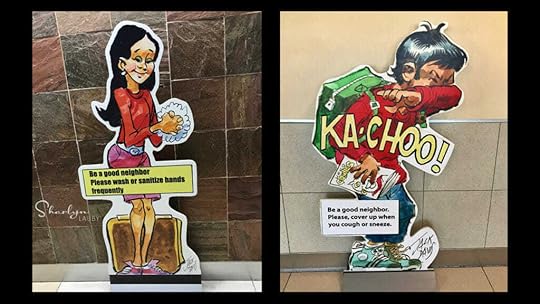
While we’re hearing some very encouraging news about COVID-19 vaccines, it’s important to remember that the approval and distribution of a vaccine is going to take some time. How long? Honestly, I don’t know. But I do know that we will not be able to miraculously flip a switch one day and resume our pre-pandemic activities.
As business professionals, we will still be responsible for managing a safe workplace for our employees. Some of the processes we have in place might be around for most of next year. Maybe even longer. I thought it could be helpful to put in one place a list of articles that you might want to keep handy.
Reopening After COVID-19: 7 Workplace Questions
In reopening the workplace after COVID-19 sheltering, we all have the same goals. Now is the time to think about 7 critical things for recovery.
7 Things to Include in Your “Welcome Back to the Office” Letter
When you welcome back employees to the workplace after COVID-19, you might want to consider including these 7 things. It’s a real opportunity to build employee engagement.
What Employers Need to Know about Face Masks and Taking Temperatures for COVID-19
As employers bring staff back, what do they need to know about face masks for COVID-19? Attorney Carrie Cherveny shares her knowledge about employer legal requirements.
COVID-19 Communications: What Employers Can and Can’t Share with Employees and Customers
Employers are bringing staff back to the workplace. Here’s what employers can legally share with employees and customers about COVID-19.
A Compliant Return to Work Plan: 7 Tips
A compliant return to work plan is essential as companies bring employees back to the workplace. Here are 7 tips to be both safe and compliant.
Can Companies Mandate Employees Return to the Workplace During COVID-19
Can companies require that employees return to the workplace during COVID-19? Attorney Carrie Cherveny with HUB International explains employer best practices.
Contact Tracing for COVID-19: What HR Needs to Know
Contact tracing is now an important part of managing COVID-19. HR needs to know about it. Ultimate Kronos Group (UKG) explains contact tracing for the workplace.
Travel During COVID-19: Employer and Employee Obligations
Business travel is back but it needs to be safe during the COVID-19 pandemic. A HUB International attorney shares employer and employee obligations.
Establishing Workplace Safety Guidelines During COVID-19
Safety is a priority as employers bring staff back to the workplace. An attorney from HUD International talks about COVID-19 guidelines.
One of the things that occurred to me while I was putting this list together is that these articles could serve as a roadmap for an emergency plan. I’m sure that doing some sort of debrief is on the company’s to-do list, but it might not have happened yet. It could be too early to do a full debrief of everything that’s taken place over the past year.
When the time is right, think about how these articles might help the organization develop an emergency plan or audit an existing plan. Our next emergency might not be a pandemic, but that doesn’t mean we shouldn’t have something in place to make sure employees and customers are safe.
Image captured by Sharlyn Lauby while exploring the streets of Atlanta, GA
The post Bookmark This! 9 COVID Resources You Might Want to Keep Handy appeared first on hr bartender.






December 1, 2020
4 New State and Local Labor Laws That May Go Federal
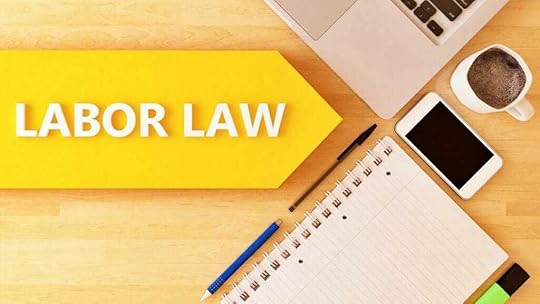
(Editor’s Note: Today’s article is brought to you by our friends at Poster Guard® Compliance Protection, a division of HRdirect and the leading labor law poster service that gets your business up to date with all required federal, state and local labor law postings, and then keeps it that way — for an entire year. Enjoy the article!)
Following every election, there’s always speculation about employment law and whether there will be an increase in employment-related legislation. Sometimes that speculation is focused on a federal level, but we can’t ignore the focus at a state and local level.
When thinking about compliance, organizations have to remember that state and local labor laws are just as important. According to Ashley Kaplan, Esquire, senior employment law attorney for ComplyRight, the volume of state and local employment law has been increasing. “There are several new state and local trends prompting more poster changes, such as increasing minimum wage rates, new employee safety and health laws, paid sick leave, and expanded anti-discrimination laws.”
One of the organizational shifts I’m seeing is when businesses make the conscious decision to adopt certain provisions of state and local legislation from other jurisdictions – even when it isn’t required – because they feel it makes good business sense and might eventually become federal law. For example, many employers banned discrimination based on sexual orientation and gender identity well before the Supreme Court issued its landmark 2020 decision clarifying these are protected characteristics under federal labor laws.
Kaplan says another reason that organizations might adopt employment trends before they become law is because they may have one location affected and it is easier for consistency to apply it across the board (e.g., allowing paid sick leave to accrue the same way for multi-location organizations based on the most generous version of the law applicable). Here are a couple examples of state and local legal trends that are causing organizations to update their practices:
Ban the Box: Effective in 36 states and more than 150 cities and counties, the intent of these laws is to eliminate the stigma of a criminal record. They limit pre-employment inquiries about criminal history and require employers to remove the check box on employment applications asking if someone has a criminal record.
Salary History: This legislation is designed to create equity in compensation. It’s effective in 16 states plus Puerto Rico and some local counties. During the hiring process, including on written job applications, employers may not ask candidates for salary history information. The intent is to break patterns of discrimination and have employers pay based on a candidate’s skills and value, not what they’ve made previously.
Now you might be saying, “Oh sure, we’re on top of those labor laws.” I knew about them too. But in researching this article, I learned about a couple more trends that I didn’t know existed.
Natural Hair Discrimination: Currently effective in 7 states and at least 5 cities and/or counties. This law prohibits discrimination based on one’s natural hair including afros, braids, twists, and locks to prevent disparate impact discrimination against Black individuals.
Predictable Scheduling: Currently in Oregon and in Emeryville, CA, San Francisco, CA, Seattle, WA, New York City, NY, Philadelphia, PA, Chicago, IL, and gaining in popularity. This law requires employers to pay employees if their schedules change suddenly.
I could see both of these laws being very similar to Ban the Box and Salary History. They’re laws that not only make good business sense but protect workers and promote fairness, which is why I can see them being enacted in more states and possibly adopted on a federal level. HR pros need to know that it’s a real possibility.

In addition to the speculation about what may or may not become new labor laws, there are employment trends happening right now that will definitely change posting requirements. For example, since the federal minimum wage hasn’t increased in quite some time, many states, counties, and cities are increasing wages. In my home state of Florida, voters just approved a ballot initiative to raise the state minimum wage to $15/hour by 2026. I’m sure there are other states that are in the same situation.
Honestly, keeping track of all these trends is tough. And while it’s important, it’s also a huge drain on our time. Fortunately, HR departments don’t have to do this alone. HR can partner with companies like HRdirect. Their Poster Guard Compliance Protection service monitors legislation at a federal, state, and local level. They will replace labor law posters whenever a mandatory change occurs within 1 full year of purchase.
It’s a great time saver. Especially when we have so many other things that we need to be working on like making sure that onsite and remote employees have all the tools they need to be successful. Oh, and don’t forget annual benefits enrollment! If you want to learn more about Poster Guard Compliance Protection service, check out their website. HR Bartender readers receive a special $30 discount off Poster Guard Compliance Protection including FREE ground delivery right now using the code SC32767. Don’t miss out!
As HR professionals, we need to stay on top of legislation at a federal, state, and local level. In addition to knowing the law, we need to know how organizations can maintain compliance.
The post 4 New State and Local Labor Laws That May Go Federal appeared first on hr bartender.






November 29, 2020
Is My Company Using an Offensive Term – Ask #HR Bartender
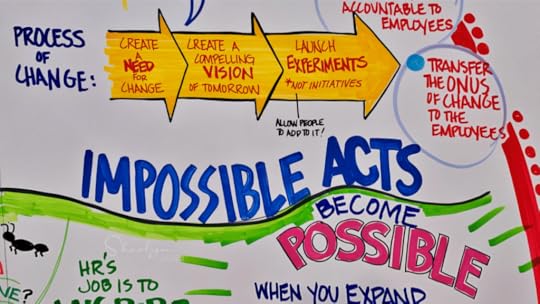
I believe today’s reader note represents a situation that can happen to anyone. It might not involve the same word or phrase, but it creates the same dilemma.
I have a question. I heard someone on a workplace conference call use the term ‘tribal knowledge’ to indicate that the procedure being discussed was known internally but it was not documented. It gave me immediate pause and so I did a search which indicated that the term isn’t considered to be culturally insensitive.
I’m not sure that I agree with the response I found on the internet just because it doesn’t indicate an affiliation with a real Native American tribe. I don’t want to be overly sensitive, but if it gave me pause and it doesn’t reflect my heritage, I am wondering if it is a term that should be normalized or dropped from workplace buzzwords. Thoughts?
I have to admit that I don’t hear the term “tribal knowledge” very often, so I did the same thing as the reader and looked it up on the internet. I found articles saying, “no, it’s not offensive because it isn’t affiliated with a specific tribe of people” as well as articles that said “yes, it is offensive because it’s disrespectful to indigenous peoples who refer to themselves as tribes”.
I can’t tell someone what to be offended by. I think that’s what makes this situation so challenging. So, I reached out to a colleague for some insights. Anthony Paradiso SHRM-CP is a human resources business partner with Industrial U.I. Services. He’s also the founder of ALLThingzAP, which specializes in diversity and inclusion matters. I’m a regular reader of his blog where he encourages individuals to be their authentic selves.
Anthony, thanks for being here. From this situation, I can see an employee hearing something that gives them pause but wanting to do some research before saying anything. If an employee is trying to figure out if something is cultural misappropriation or socially inappropriate or offensive, what’s the best way for them to learn or find the answer?

[Paradiso] I’m a believer of having those tough uncomfortable conversations. I often say that we have to learn to be comfortable with being uncomfortable. If an employee is offended by a term, they should be able to openly and freely express themselves. When having these conversations, make sure that they are in a private setting. It is important that both employees listen carefully, have an appropriate tone and energy, discuss and work together to resolve agreements and disagreements, and follow through on commitments while building on successes.
It is recommended that if one uses a term that they are not sure about in the workforce, that they should certainly look it up and discuss with human resources. Better yet, discuss with an inclusion and diversity officer, diversity council, employee resource group, etc.
Ultimately, an open conversation leads to a healthier and transparent workforce where employees are empowered by each other and the organization’s mission.
One of the things that I’m personally struggling with in this situation is if an employee feels that a term is culturally insensitive but there are no articles out there to support their feelings, that shouldn’t mean they’re wrong. Is there some way to help?
[Paradiso] There is not a one size fits all with the handling of these situations. Organizations should have policies in place that guide employees with the proper steps and have internal protocols surrounding sensitive topics. This can include anticipating employee concerns and ensuring organizations measure potential solutions and company values.
Just because there isn’t an article out there to support one’s feelings doesn’t mean that the term is not offensive. There are constant changes happening in the world that are not necessarily found in an article.
I cannot stress enough the importance of having the tough conversations. If an employee is offended by a term, let the employees discuss. Professionally and personally, we need to start having difficult conversations…not just starting them but embracing them.
Let’s say an employee feels that their manager or organization is using an inappropriate term – like tribal knowledge – how should they approach the matter?
[Paradiso] If an organization does not have a policy and/or protocol in place, now is the time. If an employee has an issue with a term they deem inappropriate, the proper steps need to be at their disposal.
There are a few ways to handle the above question. First, the employee can discuss directly how they feel with their manager. Hopefully, the manager understands. However, there’s a slight chance the manager will not. If the manager does not understand, a neutral third party needs to step in immediately such as human resources or a diversity and inclusion (D&I) officer.
I’ve seen discussions specifically on social media that there are individuals who are strongly opposed to the word ‘tribe’. I respect them as individuals and therefore do not use the term tribe. Instead of ‘tribe’, one can easily just use ‘community’. It really is that easy.
Shifting the conversation from the individual to the company. An employee does approach the company and shares their feelings that something is offensive. How should the organization respond?
[Paradiso] There is a quick answer to this. If the employee feels a certain word is inappropriate, there’s a reason why. Organizations should never undermine how an employee feels. It begins with education and continues with having conversations. It is an organization’s responsibility to educate their employees surrounding inclusion, diversity, equity, and belonging. Educate employees about why the word ‘tribe’ is offensive. After educating, discuss. Listening is key. Let’s start having these difficult conversations.
I also want to point out that hiring a D&I consultant for an hour to train an organization about unconscious bias, sensitivity training, the importance of inclusion, etc. is not a viable solution. One hour of training is not enough. Continuous education surrounding inclusion, diversity, equity, and belonging takes time and is well worth the investment and commitment. The end result will include employees who become better people, organizations that flourish as their employees feel included, and satisfaction in doing what is right.
Transparency is essential. As an employer, when an employee is uncomfortable with a term you should want them to come forward. According to Forbes, “People produce their best work when tensions are dissipated, and challenges are solved swiftly and with a sensible and transparent approach.”
Last question. I’m sure there are lots of organizations who have buzzwords or phrases that they consider part of what makes their culture special and unique. And not intentionally offensive. Is there a way for organizations to “audit” their culture to make sure they are being inclusive and respectful?
[Paradiso] If an employee brings up that a certain word or phrase is insensitive and that they are uncomfortable, there’s a reason why. Trust the employee.
Additionally, have employees complete confidential surveys. Be proactive rather than reactive. Organizations should also have a diversity council and employee resource groups that can be a part of the conversation.
I’ll be honest, it really is not difficult. If an employee comes to me and states that they are not comfortable with a certain term, I listen and comply because I respect that employee as an individual. It all boils down to respect and empathy.
I want to extend a huge thanks to Anthony for sharing his knowledge with us. You can stay in touch with him by subscribing to his blog or following him on Twitter.
I also want to add one thing. As Anthony mentioned, organizations want employees to come forward with their concerns. It makes the workplace better. But employees will only come forward when they feel it is safe to do so. It’s the concept of psychological safety. There’s a difference between uncomfortable and unsafe. Organizations have to create safe work environments so employees can have uncomfortable conversations.
Image captured by Sharlyn Lauby at the SHRM Annual Conference
The post Is My Company Using an Offensive Term – Ask #HR Bartender appeared first on hr bartender.






November 22, 2020
Establishing Workplace Safety Guidelines During COVID

Last week, I spoke with friend and attorney Carrie Cherveny about whether organizations can mandate that their employees return to the workplace during the COVID-19 pandemic. It’s a really interesting read and it may answer a lot of questions for both employers and employees. I hope you’ll check it out.
During our conversation, we started talking about workplace safety and workers’ compensation as it relates to COVID-19. So, I wanted to dedicate an article exclusively to the subject.
Before we start talking about COVID-19 and workplace safety, let me introduce Carrie Cherveny. Carrie is senior vice president of strategic client solutions in HUB International’s risk services division. In her role, Carrie works closely with clients to identify compliance risks across the organization and develop responsive strategies that ensure compliance and further overall organization goals, including risk mitigation when it comes to various insurances such as health and welfare programs and employment practices liability.
If Carrie’s name sounds familiar, it’s because she has helped us before with COVID-19 information. I love her insights on this article about business travel during the pandemic. As always, please don’t forget that since Carrie is a lawyer, her comments shouldn’t be construed as legal advice or as pertaining to any specific factual situations. If you have detailed questions, they should be addressed directly with your friendly neighborhood labor and employment attorney.
Carrie, in part one of our interview, we talked about what employers can and cannot do when it comes to mandating an employee’s return to work. That being said, should employers require that employees come back to the office? It’s a slight distinction but I believe an important one. And are there a couple of things that companies should consider when making that decision?
[Cherveny] The Centers for Disease Control (CDC), the Equal Employment Opportunity Commission(EEOC), and the Occupational Safety and Health Administration (OSHA) all encourage employers to be flexible and to allow employees to continue to telework where possible. If an employer decides to require employees to return to work, it must address workplace safety and return to work policies/programs.

In addition to safety protocols, employers should create a process through which an employee can raise concerns and/or ask for changes to work schedules, duties, and/or locations. As a threshold matter, employers cannot single out employees and ask them about any underlying health conditions or if they are in the CDC high-risk categories. However, they may open the door for employees to self-identify their concerns or special circumstance. If the employee requests a change in their working arrangements due to an underlying medical condition outlined by the CDC, the employer is responsible for following the interactive process under ADA to determine if a reasonable accommodation can be made.
The EEOC instructs that there may be lost-cost solutions available to employers that will provide an accommodation for the employee. For example, there may be ‘materials already on hand or easily obtained [that] may be effective.’ Employers may make changes to the work environment including one-way hallways, social distancing in common areas, reduced seating capacity in conference and break rooms, and installing barriers between employees and customers. Employers may also consider temporary job restructuring, temporary transfers to a different position, and modifying work schedules.
However, employers should proceed with some caution. The EEOC has made clear that an employer may not exclude an employee from the workplace solely because they are someone that the CDC has identified as a higher-risk for serious illness with COVID-19. For example, employers may not require all employees over age 65 or immune compromised to work from home. An employer may only do so if the employee’s condition poses a ‘direct threat’ to the employee’s health and that direct threat cannot be eliminated by a reasonable accommodation.
As an aside, it’s important to note that the ‘direct threat’ is a very high standard and requires a case-by-case assessment. Employers must rely on reasonable medical judgment about the specific employee’s disability (not a generalized assessment) using the most current medical knowledge and/or the best objective evidence. However, even if the employee’s condition does pose a direct threat to the employee’s health, the employer still may not exclude the employee from the workplace unless there is no available reasonable accommodation that will not pose an undue hardship on the business.
Over these past two articles, we’ve been talking about employees returning to the workplace. It raises the question: Are companies required to create COVID-19 compliant workplaces? What are a couple of things that organizations will have to consider doing to bring employees back to the workplace?
[Cherveny] The OSHA General Duty Clause states that each employer:
Shall furnish to each employee, employment and a place of employment which are free from recognized hazards that are causing or are likely to cause death or serious physical harm to his employees;
Shall comply with occupational safety and health standards promulgated under this Act.
Each employer must comply with occupational safety and health standards pursuant to the General Duty Clause which are applicable to the employee’s own actions and conduct.
In addition to the OSHA obligations, employers may also face liability from employees seeking compensation. In most situations, employers believe an employee who experiences an injury or illness in the workplace may be covered by workers’ compensation insurance. However, workers’ compensation generally does not respond to a pandemic unless there is demonstrable proof that the condition was solely contracted within the course and scope of the job duties. For example, most workers’ compensation carriers have agreed that first responders and healthcare professionals would likely receive coverage for a COVID-19 claim, but this will vary from state to state. As a side note: Those states that are part of the NCCI (National Council on Compensation Insurance) should refer to the latest information at on the NCCI website. Other states or provinces should refer to their jurisdiction’s Department of Labor (DOL) website for guidance.
In your experience, what are you seeing when it comes to COVID-19 cases and workers’ compensation?
[Cherveny] Most workers’ compensation state statutes include a provision called the ‘exclusive remedy’ provision. The exclusive remedy provision provides that an employee’s only course of action and remediation is through the workers’ compensation claims process unless the employee experiences retaliation by the employer.
Because workers’ compensation carriers may not cover COVID-19 cases, the exclusive remedy provision does not apply and employee-litigants (and their attorneys) are free to pursue other legal causes of action (absent any state statutes to the contrary). Consequently, both public nuisance and negligence claims have been gaining traction in the courts.
Recently, cases have been filed against employers arguing that the employer did not act reasonably to provide a safe working environment to their employees. In particular, there have been a number of class actions lawsuits filed against employers under two causes of action: (1) negligence; and (2) public nuisance. Under both causes of action, plaintiffs argue that the employer did not engage in the appropriate protocols to ensure the employee’s health and safety in a COVID-19 working environment and as a result the employee suffered harm and/or damages. Many of the claims rely on similar allegations – some examples of those allegations include the employer’s failure to:
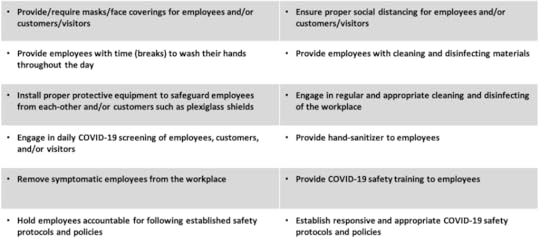
Employers may find these allegations instructive and should consider them as they build and implement their workplace COVID-19 safety programs. It’s important that employers understand their obligations and their rights to mitigate and manage the risk of working in the new COVID-19 environment.
What types of policies and procedures should employers consider to make their workplaces more safe for employees?
[Cherveny] Employers should consider creating new policies and standards of conduct (and updating existing policies) for employees in the workplace related to COVID-19. For guidance on building your own COVID Safety Program, see the HUB COVID Safety Policy – Self Inventory for recommendations. More specifically, new policies (and/or updated language) may include:
COVID-19 Safety Requirements – Federal
Standards of conduct – Including handwashing, hand sanitizing, sharing of equipment, dissemination of hard-copy documents, donning and doffing of personal protective equipment (PPE), social distancing, and workstation cleaning and disinfecting.
Face-masks, face-coverings, employee accommodations, and face shields – Specifically, the DOL, in its recently issued FAQ (June 11, 2020) has delineated between ‘face-coverings’ which are cloth and often home-made and ‘face-masks’ which are the ‘surgical’ masks (some however do not meet the surgical standards). While face-coverings are not considered PPE, the DOL reminds employers of their General Duty Clause obligations to provide a safe working environment.
Employers may require employees to wear face masks or cloth face coverings as a reasonable means of controlling community spread as part of a larger COVID-19 health and safety plan. Employers have the discretion to determine whether to allow (and/or require) employees to wear cloth face coverings in the workplace based on the specific circumstances present at the work site.
COVID-19 Safety Requirements – State and Local
Beyond the recommendations provided by the DOL, some states and local jurisdictions are requiring face coverings at businesses, as part of their COVID-19 mitigation strategies. In areas where face coverings are mandated by state or local authorities, employers should adhere to these requirements as specified.
Performance, Accountability, and Compliance – Details and consequences regarding prohibited conduct and failure to comply with the standards of conduct such as coming to work with COVID-19 symptoms, failure to socially distance in the workplace, failure to wear and utilize PPE, and failure to disinfect/clean working areas and equipment.
Workplace “Traffic” Rules – Regarding entering and exiting the building to ensure social distancing. For example, only two people in an elevator at one time and/or the requirement to wash one’s hands before entering the office or workspace.
Attendance and Calling-in Rules – New procedures and policies regarding calling in sick, incentives to remain home when sick rather than come into the office (even if the employee feels they can work), and what circumstances or symptoms require (or mandate) employees to remain home.
Visitors and Children in the Workplace – Should an employer allow children and/or visitors in the workplace, especially if they will face a significant challenge adhering to social distancing requirements.
In fact, in the early stages of re-opening, employers will likely bring back a small percentage of the total employee population to facilitate social distancing and limit risk and exposure. Adding children or other visitors to the number of people in the workplace would be counterproductive and hinder the employer’s efforts to mitigate the risk of COVID-19 in the workplace.
Employee Acknowledgements – Employers should disseminate new policies to employees and require the employees to sign an acknowledgement that includes the obligation to read and comply with the policies. In addition, employers should explain the consequences for failure to comply. Finally, the acknowledgement should remind employees that they are employed ‘at will’ and that compliance does not provide a guarantee of continued employment.
Employee Communications – In an effort to limit risk and exposure, employers should consider leveraging their technology to deliver employee communications including new policies. Most HR, payroll and/or learning management systems have functionality to enable electronic distribution and acknowledgement tracking. Consider leveraging these systems to complete this process, which in turn align with new safety protocols.
I simply cannot thank Carrie enough for sharing her knowledge with us. If you’re looking to stay up-to-date with pandemic information, be sure to check out HUB International’s COVID-19 FAQ. This is a 200+ question FAQ updated each week to consolidate the ever-changing and updated regulatory information across all aspects of employment including benefits, health and safety, and employee relations.
It’s hard to believe we’ve been dealing with COVID-19 for almost a year. And there are still so many things we don’t know and circumstances we’re being faced with for the first time. Like workers’ compensation and workplace safety during a pandemic. Thankfully, there are knowledgeable contributors like Carrie and resources available to help us navigate.
The post Establishing Workplace Safety Guidelines During COVID appeared first on hr bartender.






November 19, 2020
Should You Take a Fake Commute [POLL]

I ran across an article on LinkedIn recently titled “The Rise of the ‘Fake’ Commute”. The gist of the article is that having a commute to/from work defines our workday. With the increase of people working from home, the lack of a commute could be impacting some peoples’ ability to stay balanced. Because there’s no clear delineation between work and home life.
I’m curious to know what you think about this. One of the things that I regularly hear from people who work from home is that they love not spending time commuting. No traffic to deal with is glorious! However, the other side is if you work from home and can’t find a way to “shut off” work, then you end up miserable. Too much work. Not enough fun.
The pandemic isn’t making this any easier. In my experience, if you work from home, you might go out to separate yourself from your work. Going to a gym, visiting a coffee shop or restaurant, or running errands can keep you in touch with the outside world. But COVID-19 is keeping us at home where we’re staring at our work all the time.
So, what can we do? Back when the pandemic first came into the news, I remember seeing someone say that they would take a walk around their neighborhood at the beginning and end of their workday. I guess we could think of it as that “fake” commute. I could see it being a great way to get into the right frame of mind (either gearing up for or winding down from the workday) and even exercising at the same time. Can’t image a typical commute would accomplish the same thing.
Other things that could be identified as a “fake” commute include reading, listening to music or a podcast, watching a TV show, etc. It’s really about coming up with some activity that draws that line of separation between work and home. So, I hope you’ll take a moment to answer this completely unscientific one question survey about “fake” commutes.
As always, we’ll leave the survey up for a couple of weeks and then I’ll share the results. Thanks in advance for taking a moment to respond.
I do think this idea of a “fake” commute is interesting. As someone who has worked at home for years, it does make me wonder if adding a “fake” commute would be a nice change of pace? Would it bring some new life to my routine and productivity?
As I think about the winter months and the pandemic, I do believe remote workers will need to find ways to be productive. They will also need to find ways to separate themselves from work and having fun.
The post Should You Take a Fake Commute [POLL] appeared first on hr bartender.






November 17, 2020
Delivering Jobs and Creating Inclusion for Individuals with Intellectual Disabilities
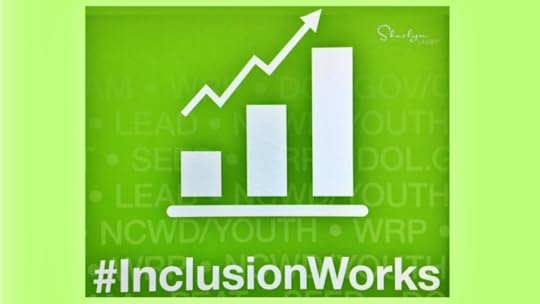
Only 13% of U.S. workforces have disability-specific inclusion initiatives, according to research from the Society for Human Resource Management (SHRM). The same research indicates that more than half of people managers haven’t participated in any type of disability inclusion training. Wendi Safstrom, executive director of the SHRM Foundation says the data “signals a deep knowledge gap in disability inclusion in the workplace.”
To create a more inclusive workplace culture and environment, SHRM and the SHRM Foundation partnered with Entertainment Industry Foundation (EIF) through the Delivering Jobs campaign to bring awareness to the contributions people with disabilities bring to the workplace. Safstrom shared what’s special about this partnership is that it works to engage HR professionals and empowers them with the tools and resources they need, not only to hire inclusively, but to underscore the unique talent, experience, and perspective individuals with disabilities bring to the workplace.
I had the opportunity to chat with Safstrom recently about the Delivering Jobs program and how HR professionals and organizations can benefit from the partnership. (Side Note: If you’re not familiar with the SHRM Foundation, I wrote an article about it a few years ago. It’s one of SHRM’s “best kept secrets”. Check it out when you have a moment.)
Wendi, thanks for taking the time to chat about this great campaign. There’s a lot of information on the Delivering Jobs website, so readers can get details there. Can you share with everyone how the SHRM Foundation got involved in this initiative?

[Safstrom] Our mission at the SHRM Foundation is to help HR create a better world by tapping into the potential of people who get left out or overlooked for no good reason. Research shows individuals who are differently abled bring tremendous perspective, talent, and value as they help create a more inclusive workplace. In other words, inclusive hiring isn’t just a nice thing to do. It’s a good thing for society, our communities, families—and the business, too.
The COVID-19 pandemic has turned the workplace on its axis, and we’ve seen firsthand how the unprecedented changes and challenges workers have faced has had a significant impact on the job market and talent.
The Delivering Jobs partnership empowers HR professionals to hire inclusively while underscoring the unique talent, experience, and perspective individuals with disabilities bring to the workplace. The initiative aims to create pathways to 1 million employment opportunities by 2025.
The Delivering Jobs website offers an assessment and resources for employers and job seekers. How can job seekers get the most out of this feature?
[Safstrom] The Delivering Jobs website provides job seekers with disabilities the tools and resources they need to sharpen their leadership skills and find potential job opportunities. This includes resources such as educational programs, job boards, and programs to help prepare individuals for different career paths and leadership positions. The self-assessment resource can help users figure out where they currently are in their employment journey and equip them with the appropriate resources to get to the next step.
If I’m an HR professional trying to convince my organization that hiring individuals with disabilities is good for the company (and not a financial burden), what are a couple of things I should do?
[Safstrom] There is a strong business case for hiring people with disabilities—it can result in cost savings, reduced turnover, and improved productivity. Nearly all HR professionals and people managers say that employees with disabilities regularly perform the same or better than their peers without disabilities.
HR professionals play an instrumental role in making employees with disabilities feel secure and supported while continuing to promote inclusion in the workplace. The first step is creating awareness and celebrating and supporting employees’ differences across all aspects of the business. It’s also crucial for organizations to check their inclusivity across the board—from the hiring process, to building and website accessibility.
If my organization already hires individuals with disabilities, what’s one thing we can do to make sure that our culture is supportive and inclusive?
[Safstrom] As we navigate an evolving workplace amid a pandemic, it’s more important than ever to ensure employers support individuals with disabilities. It’s critical that organizations check their inclusivity across the board—whether it’s training managers and holding them accountable, making sure workers have a safe space to express concerns, or even forming an inclusion council—creating a workplace culture that truly values differences can help every worker feel supported in their jobs and contribute to their team.
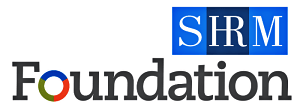
To do this, HR professionals and people managers must understand how expand awareness of employment challenges individuals with disabilities face, and most importantly, make sure they are included. We celebrated the 30th anniversary of the Americans with Disabilities Act this summer—while progress has been made, there is still much work to be done to elevate awareness around the value individuals with disabilities bring to the workplaces of today and of the future.
Last question. I noticed on the Delivering Jobs website a mention of the Employing Abilities @Work certificate. Who is the target audience for this certificate? What does it consist of?
[Safstrom] Our research found people with disabilities have an unemployment rate that is double the national average. The Employing Abilities @Work initiative aims to help HR professionals and business leaders strengthen their skills to hire and retain individuals with disabilities in their workplace—and help them grow and advance in their careers.
The Employing Abilities @Work Certificate program is designed for human resources professionals and hiring managers to foster inclusion at work. It aims to dispel myths and highlights how recruiting employees with disabilities can bolster the workplace. The program includes 12 micro-learning modules that focus on how to welcome and support employees with disabilities in the workplace.
A huge thanks to Wendi for sharing her knowledge with us. If you want to learn more about the work of the SHRM Foundation, visit their website.
Years ago, I was honored to be appointed to the Florida Governor’s Alliance for the Employment of Citizens with Disabilities. Not only was I able to contribute my experience and expertise about recruiting and retention, but I was able to learn more about hiring, engaging, and retaining individuals with disabilities in the workplace. Partnerships like Delivering Jobs are so necessary and needed. I hope you’ll take the pledge. It will only make your workplace stronger and more inclusive.
Image captured by Sharlyn Lauby at the SHRM Annual Conference
The post Delivering Jobs and Creating Inclusion for Individuals with Intellectual Disabilities appeared first on hr bartender.






November 15, 2020
Can Companies Mandate Employees Return To the Workplace During COVID-19

I know that many organizations (and individuals) are anxious for a return to normal. Trust me, I am too. But with COVID-19 cases starting to spike again in many areas, I’m seeing a lot of questions about whether employees can and should return to the workplace. So, I thought it might be good to talk about it.
To help us understand the intricacies of this, I reached out to my friend and attorney Carrie Cherveny to see if she would offer us some insights. Carrie is senior vice president of strategic client solutions in HUB International’s risk services division. In her role, Carrie works closely with clients to identify compliance risks across the organization and develop responsive strategies that ensure compliance and further overall organization goals, including risk mitigation when it comes to various insurances such as health and welfare programs and employment practices liability.
If Carrie’s name sounds familiar, it’s because she has helped us before with COVID-19 information. Her comments on employer communications is worth a read. As always, please don’t forget that since Carrie is a lawyer, her comments shouldn’t be construed as legal advice or as pertaining to any specific factual situations. If you have detailed questions, they should be addressed directly with your friendly neighborhood labor and employment attorney.
Carrie, let’s start with the big question. Can organizations require (or mandate) that employees come back to the office?
[Cherveny] Yes. Employers are free to build and implement their workplace policies as they see fit. However, there are some important regulatory exceptions. Employers may be required to make adjustments or allowances for employees with medical conditions protected under the Family and Medical Leave Act (FMLA) and/or the Americans with Disabilities Act (ADA).
We’ve all heard of the FMLA and ADA. But we don’t have a lot of experience with them during a pandemic. As a refresher, how do these pieces of legislation work with COVID-19?

[Cherveny] Let’s start with FMLA. Like we talked about in the travel article in September, good-old-fashioned traditional FMLA for the serious health condition of a family member applies to employers with 50 or more employees in a 50-mile radius. ‘Traditional’ FMLA provides up to 12-weeks of job and health insurance protections but it is an unpaid program.
A few additional reminders about FMLA. The employee must have been employed for 12 months and at least 1,250 hours in the 12-month prior to the FMLA. If both criteria are met, the employer will likely provide an employee with a Certificate of Healthcare Provider for Employee Family Member’s Serious Health Condition. Once the employer receives the completed and sufficient certificate of health care provider it will be able to determine whether the employee is eligible for FMLA.
FMLA leave may be intermittent or continuous. It’s important to note that the FMLA is premised on the employee’s inability to work. An employee who is able to work but requests to do so from home because of an underlying medical condition won’t qualify for FMLA but may be eligible for a job accommodation under the ADA.
With the ADA, the Centers for Disease Control (CDC) has identified a number of conditions that can potentially put individuals at greater risk if they contract COVID-19. If the employee requests a change in the workplace because of an underlying medical condition outlined by the CDC, the employer is responsible for following the interactive process under ADA to determine if a reasonable accommodation can be made.
The employer can verify the employee’s disability and that the accommodation is needed because (1) the disability puts the employee at higher risk if they contract COVID-19; or (2) the employee’s disability would be exacerbated by COVID-19. Employees may have difficulty obtaining the necessary documentation to verify his/her disability because health care providers are overwhelmed by the COVID crisis.
The Equal Employment Opportunity Commission (EEOC) encourages employers to be flexible and look for other ways to confirm the information such as the record of a prescription used to treat the condition. Additionally, the EEOC encourages employers to provide employees with a temporary accommodation while waiting for documentation.
Employers and employees can consult the Job Accommodation Network (JAN) for specific ADA and COVID-19 questions and resources.
Speaking of accommodations, what about employees who might request remote work because they’re in a high-risk age category or they’re pregnant?
[Cherveny] Employees may ask for accommodations (i.e. allowances to work from home) in response to a high-risk household member (for example, age or medical condition), because the employee is age 65 or older, and/or because the employee is pregnant. Employers should note the following:
The ADA requires an accommodation for the employees’ own qualifying medical condition – not the medical condition of a family member.The Age Discrimination in Employment Act (ADEA) does not require a workplace accommodation – the ADEA is designed to prohibit discrimination on the basis of age and it does not include an accommodation requirement or provision.The Pregnancy Discrimination Act (PDA) likewise does not require an employer to accommodate an employee because she is pregnant – however – employers should proceed with caution because in some cases pregnant employees may experience medical conditions or complications that qualify as a disability under the ADA.
The CDC addresses these populations and provides this very simple and straightforward guidance to employers: Protect employees at higher risk for severe illness through supportive policies and practices.
Older adults and people of any age who have serious underlying medical conditions are at higher risk for severe illness from COVID-19.Support and encourage options to telework, if available.Consider offering vulnerable workers duties that minimize their contact with customers and other employees (e.g., restocking shelves rather than working as a cashier), if the worker agrees to this.Offer flexible options such as telework to employees. This will eliminate the need for employees living in higher transmission areas to travel to workplaces in lower transmission areas and vice versa.Ensure that any other businesses and employers sharing the same workspace also follow this guidance.
Last question. This might sound a bit odd, but I know a couple of people who have made it very clear they are not “work from home” people and want to return to the office asap. Can employees refuse to work from home? And do companies have to accommodate their request?
[Cherveny] Just like the right to require work in the office, employers can likewise require employees to work from home. I have also come across a few employees are ‘requesting’ (demanding?) to return to the office. Employers do not have to re-open their doors to employees or customers if they choose not to (unless of course there is a legal obligation to do so).
It is certainly possible for an employee to request an accommodation under ADA to return to the office. But there some significant obstacles to this accommodation request.
The employee would have to medically demonstrate why physically returning to office is a necessary or appropriate accommodation.Even if the employee can provide medical documentation regarding a return to the office, the employer does not have to choose the employee’s preferred accommodation – only the accommodation that will allow the employee to perform the essential functions of the job. If the employee does have a medical condition that requires them to work outside of the home and the business is otherwise closed, then there simply may not be any accommodation available to the employee.
I want to extend a huge thanks to Carrie for sharing here expertise. If you’re looking for additional resources, be sure to check out HUB International’s COVID-19 FAQ. This is a 200+ question FAQ updated each week to consolidate the ever-changing and updated regulatory information across all aspects of employment including employee relations, benefits, and health and safety.
Speaking of health and safety, there’s a part two to this conversation with Carrie and it has to do with COVID-19, workers’ compensation, and workplace safety. It will be coming out next Sunday, November 22, 2020. I think you will find it very interesting.
I feel pretty confident in saying none of us want to be in the middle of a pandemic. But if we’re trying to find some takeaways, it’s that we can use the administrative logic of the FMLA and ADA to help and support employees during this time.
The post Can Companies Mandate Employees Return To the Workplace During COVID-19 appeared first on hr bartender.






Sharlyn J. Lauby's Blog
- Sharlyn J. Lauby's profile
- 10 followers



